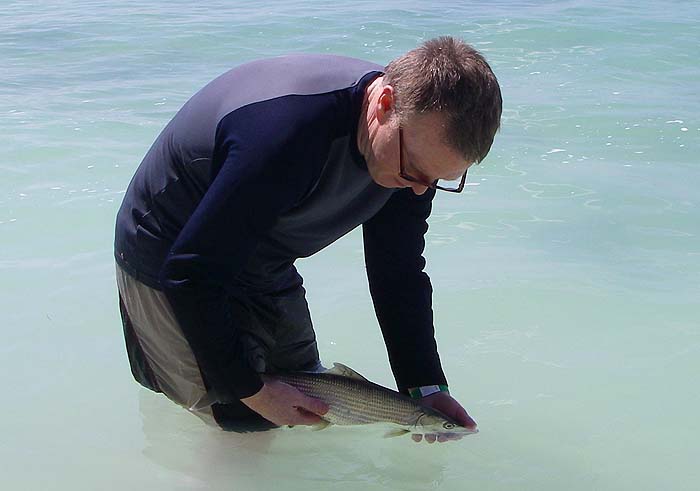

Catch Fish with
Mike Ladle
Information Page
SEA FISHING
For anyone unfamiliar with the site always check the FRESHWATER, SALTWATER and TACK-TICS pages. The Saltwater page now extends back as a record of over several years of (mostly) sea fishing and may be a useful guide as to when to fish. The Freshwater stuff is also up to date now. I keep adding to both. These pages are effectively my diary and the latest will usually be about fishing in the previous day or two. As you see I also add the odd piece from my friends and correspondents if I've not been doing much. The Tactics pages which are chiefly 'how I do it' plus a bit of science are also updated regularly and (I think) worth a read (the earlier ones are mostly tackle and 'how to do it' stuff).
Tobago 09 - Bonefish etc.
I guess that what we all really like to catch are fish that make us think "What the hell is that?" as line pours off the spool against a tight check. Of course wherever you happen to be spinning you soon learn to judge from the nature of the take, the tension on the line, the length of the runs, the amount of splashing or jumping, the headshaking and the general feel of your adversary what you are likely to have hooked. Rich and I have done quite a lot of fishing in the tropics now and we're getting reasonably good at telling what we are about to lose (or not as the case may be).
One or two examples may help. Some are easy to recognise. A sharp 'hard' bite that you fail to hook time after time suggests houndfish. On occasion you do hook one and it reveals its nature almost at once by hurling itself into the air. A slightly softer but solid bite soon becomes a small tarpon when it leaps from the water time after time. Large tarpon (of course) pull harder and may spend more time under the surface making powerful runs before launching into a headshaking jump. Snook and barracuda also jump fairly often (but not always). The take of a barracuda is a bit like hitting a fast moving car followed by a searing run with the line hissing through the water while the snook are similar but slowed down, something like a bass. Jacks are often seen blitzing before they take the lure and they simply grab hard before setting off on a series of long fast unstoppable runs. Snappers, groupers, grunts and the like all put up a fair display with punchy dragging action and assorted tugging but the really easy ones to distinguish, even though you might not see them for five or ten minutes are bonefish. You'll be winding your little plug along steadily over the flat when suddenly there is a soft steady bite, almost like hooking a lively clump of seagrass. The next thing you know the line is streaming out at speed with the clutch buzzing steadily. Thirty, forty, fifty metres leave the spool and there is no sign of the fish stopping. Sixty, seventy, eighty metres have gone and the fish ploughs steadily along its way. You look down at the spool in disbelief, glad that you filled up with thirty pound braid before you came on holiday. Eventually the fish tires and slows down, you gain a bit of line and then suddenly away it goes again, no splashing, no jumping, no headshaking just unstoppable power and stamina - wonderful!
On our recent trip to Tobago we spent several sessions after bonefish (it shows how good the other fishing was that we didn't devote ourselves entirely to this). The general idea was to wade onto the flats, a mixture of seagrass beds interspersed with slightly deeper sandy/corally patches, until the water was about 'crutch deep', and then to cast and retrieve the lures. Usually we fished fairly close together so that we could lend a hand, take a picture or help with unhooking in the event of tricky fish. To be honest a lively barracuda baring its teeth and hurtling round close to the family jewels with a couple of needle sharp trebles dangling from its jaw is not comforting. Both rods would be armed with 30lb braid (just in case) with a short trace of 15lb knottable wire looped to a small, pearl finish, Angel Kiss lure. These little plugs are very shallow divers and fish over the top of everything even when the tide is quite low. They are attractive to all sorts of fish and depending how you work them (fast for barracuda, slower for bones) it's possible to be slightly selective. In a typical session we would catch snapper, 'jack' barracuda and bonefish in the same area. We actually saw the bonefish chasing after our lures at times and on one occasion there were so many barracuda that we found ourselves playing two at once. On other trips we've landed grunts, tarpon, houndfish and even puffers doing exactly the same thing.
I must finish off with our tale of abject failure. We love catching big jacks so when we found them feeding over a reef attended by lots of royal terns,laughing gulls and pelicans we had to have a go. We waded out as far as we dared but when we managed to hook a fish it almost invariably ripped off loads of line before diving over the drop-off and cutting the line. On the only occasion did I manage to turn one of these monsters (probably the smallest one we hooked - perhaps 10kg) it shot along to the side past my buddy dragging the braid across his chest. The fish moved so fast that there was no way I could get the rod up to clear the coral so, inevitably, the lure jammed and the fish was gone. I said to Richard "At least I'll get my popper back!" and so it proved. The tail treble (a size 2, 4x strength) was jammed solidly in a coral boulder and was partly straightened. When I inspected the lure I found that the jack had simply twisted the mid-body treble off the wedged lure along with the strong, brand new, Owner split-ring. No wonder these fish take a bit of stopping. In fact the only fish we managed to land from this spot was a tarpon that took my popper and exhausted itself by jumping about over the reef. That's fishing!
If you have any comments or questions about fish, methods, tactics or 'what have you!' get in touch with me by sending an E-MAIL to - docladle@hotmail.com
Richard playing a bonefish.

Angel Kiss

Snapper.
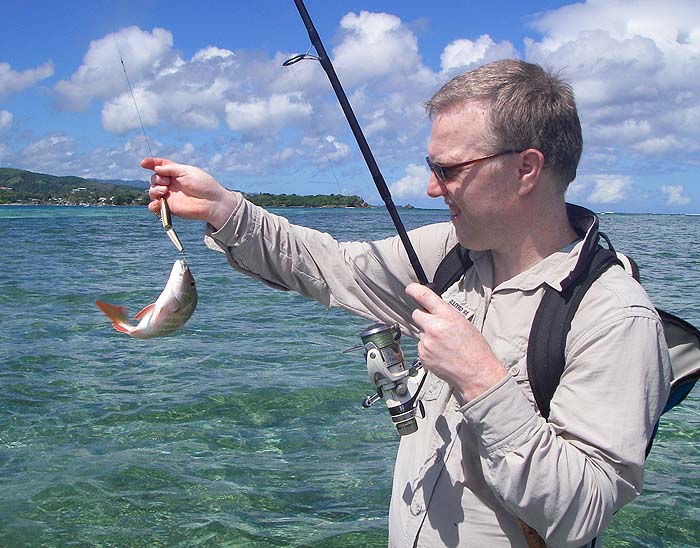
- again
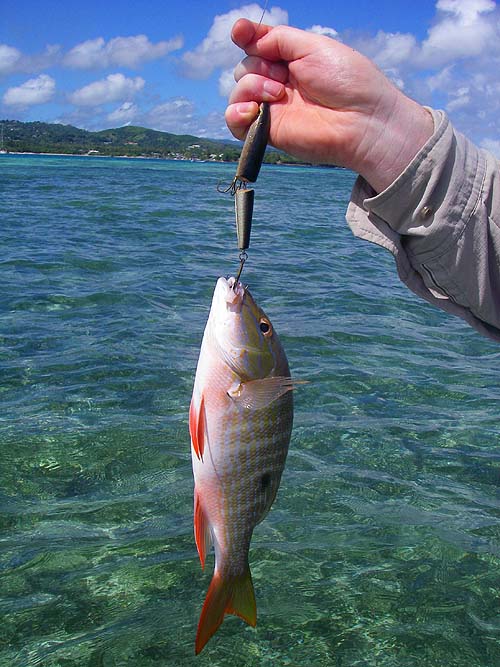
Barracuda.
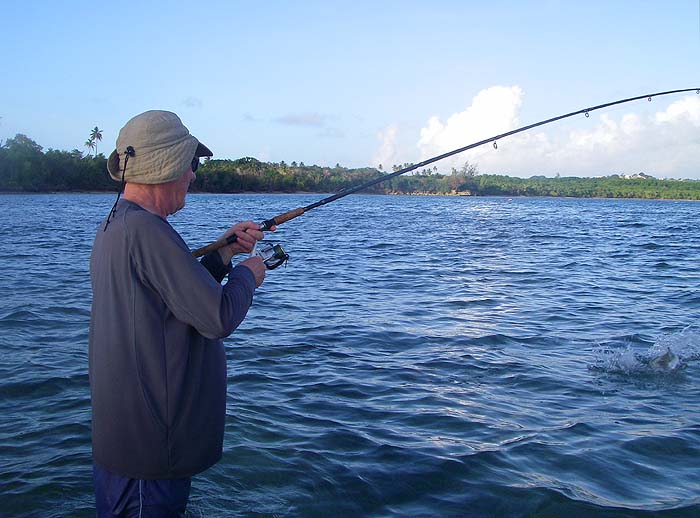
A helping hand.
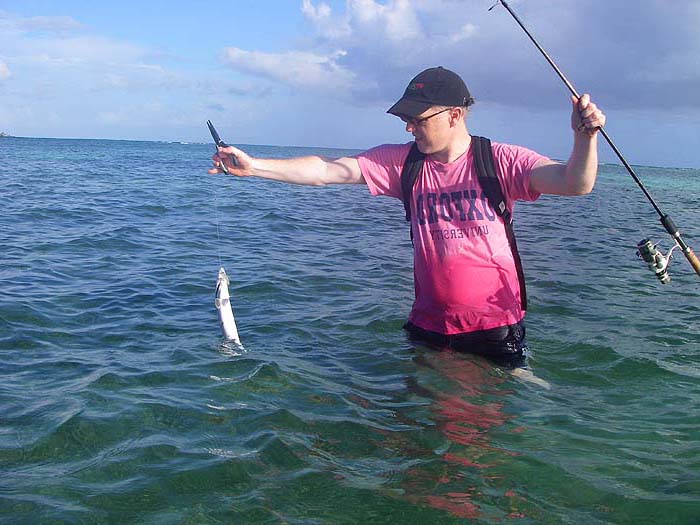
Arm's length.

Bonefish.

Another for Rich.

What a cracker!
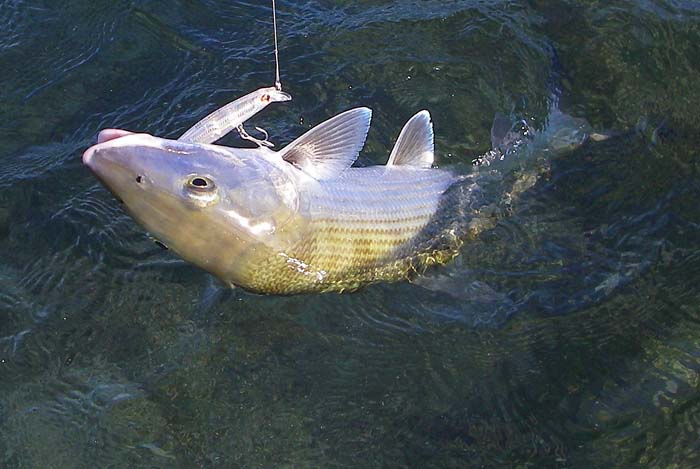
Got one!
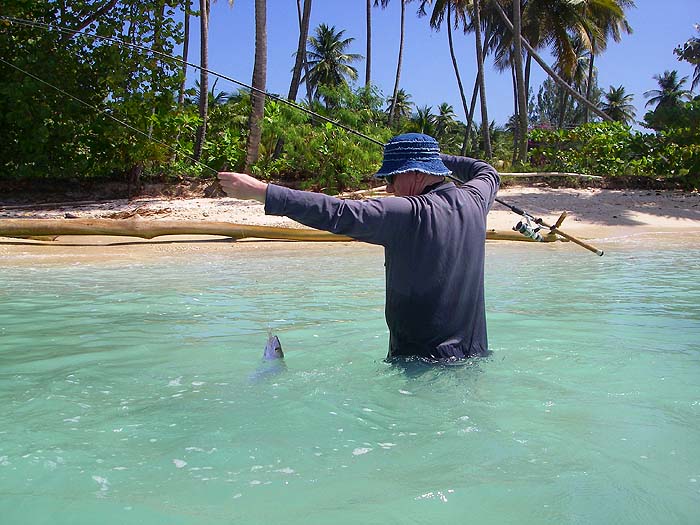
Nice fish.
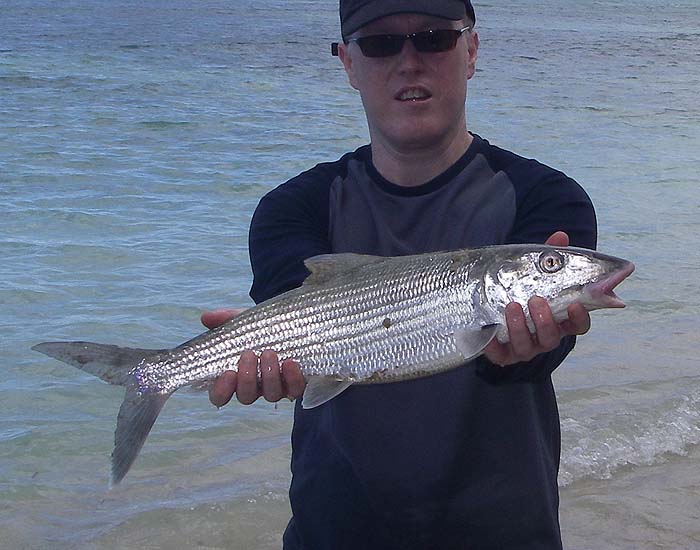
Back it goes.
